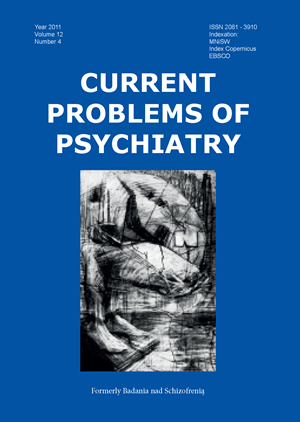CT perfusion of the brain – what is its role today and expectancies for tomorrow?
Keywords:
perfusion, CT, brain, strokeAbstract
Computed tomography (CT) perfusion imaging delivers the information about regional differences of cerebral haemodynamics and can give additional information in different cerebral pathologies. Together with CT technology it has recently undergone significant progress by expansion of multidetector CTs (four to 320 detector-rows) and enlargement of detector width. The aim of this review is to provide an overview of the newest perfusion CT possibilities in imaging of different brain pathologies and to discuss the future development directions of perfusion CT.
References
1. Orrison W.W. Jr., Snyder K.V., Hopkins L.N. et al. Whole-brain dynamic CT angiography and perfusion imaging. Clin. Radiol., 2011; 66: 566-574.
2. Dorn F., Muenzel D., Meier R. et al. Brain perfusion CT for acute stroke using a 256-slice CT: improvement of diagnostic information by large volume coverage. Eur. Radiol. 2011; 21:1803–1810.
3. Roberts H.C., Roberts T.P., Smith W.S. et al. Multisection dynamic CT perfusion for acute cerebral ischemia: the “toggling-table” technique. AJNR Am. J. Neuroradiol. 2011; 22:1077–1080.
4. Murayama K., Katada K., Nakane M et al. Whole-brain perfusion CT performed with a prototype 256-detector row CT system: initial experience. Radiology; 2009; 250:202–211.
5. Siebert E., Bohner G., Dewey M. et al. 320-slice CT neuroimaging: initial clinical experience and image quality evaluation. Br. J. Radiol., 2009; 82:561–570.
6. Page M., Nandurkar D., Crossett M.P. et al. Comparison of 4 cm Z-axis and 16 cm Z-axis multidetector CT perfusion. Eur. Radiol., 2010; 20:1508–1514.
7. Rosamond W., Flegal K., Furie K. et al. Heart disease and stroke statistics—2008 update: a report from the American Heart Association Statistics Committee and Stroke Statistics Subcommittee. Circulation, 2008; 117:e25–e146.
8. Truelsen T., Piechowski-Jozwiak B., Bonita R. et al. Stroke incidence and prevalence in Europe: a review of available data. Eur. J. Neurol., 2006; 13: 581–598.
9. Schellinger P.D., Fiebach J.B., Mohr A. et al. Thrombolytic therapy for ischemic stroke–a review. Part I—Intravenous thrombolysis. Crit. Care Med., 2001; 29:1812–1818.
10. Wintermark M. Brain perfusion-CT in acute stroke patients. Eur. Radiol., 2005; 15 (Suppl. 4):D28–D31.
11. Lövblad K.O., Baird A.E. Computed tomography in acute ischemic stroke. Neuroradiology, 2010; 52:175–187.
12. Soares B.P., Dankbaar J.W., Bredno J. et al. Automated versus manual post-processing of perfusion-CT data in patients with acute cerebral ischemia: influence on interobserver variability. Neuroradiology, 2009; 51:445–451.
13. Silvernnoinen H.M., Hamberg L.M., Lindberg P.J. et al. CT Perfusion identifies increased salvage of tissue in patients receiving intravenous recombinant tissue plasminogen activator within 3 hours of stroke onset. AJNR Am. J. Neuroradiol., 2008; 29:1118–1123.
14. Kazufumi S., Satoru M., Ai M. et al. Utility of CT perfusion with 64-row multi-detector CT for acute ischemic brain stroke. Emerg. Radiol., 2011; 18:95–101.
15. Darwish R.S., Amiridze N.S. Brain perfusion abnormalities in patients with compromised venous outflow. J. Neurol., 2011; 258:1445–1450.
16. Sanelli P.C., Jou A., Gold R. et al. Using CT perfusion during the early baseline period in aneurysmal subarachnoid hemorrhage to assess for development of vasospasm. Neuroradiology, 2011; 53:425–434.
17. Nabavi D.G., LeBlanc L.M., Baxter B. et al. Monitoring cerebral perfusion after subarachnoid hemorrhage using CT. Neuroradiology, 2001; 43:7–16.
18. Lie C.H., Seifert M., Poggenborg J. et al. Perfusion computer tomography helps to differentiate seizure and stroke in acute setting. Clin. Neurol. and Neurosurgery, 2011; 113: 925–927.
19. Bussière M., Pelz D., Reid R.H., Young G.B. Prolonged deficits after focal inhibitory seizures. Neurocrit. Care, 2005; 2(1):29–37.
20. Schramm P., Xyda A., Klotz E. et al. Dynamic CT perfusion imaging of intra-axial brain tumours: differentiation of high-grade gliomas from primary CNS lymphomas. Eur. Radiol., 2010; 20: 2482–2490.
21. Zimny A., Sasiadek M., Leszek J. et al. Does perfusion CT enable differentiating Alzheimer's disease from vascular dementia and mixed dementia? A preliminary report. J. of the Neurol. Sci., 2007; 257: 114– 120.
Downloads
Published
Issue
Section
License
Copyright (c) 2011 Authors

This work is licensed under a Creative Commons Attribution-NonCommercial-NoDerivatives 3.0 Unported License.


